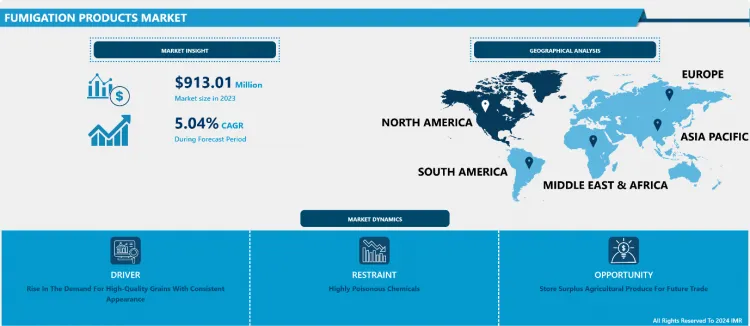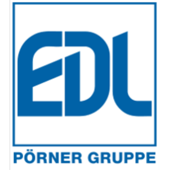Global Fumigation Products Market Overview
Fumigation Products Market size is projected to reach USD 1,421.24 Million by 2032 from an estimated USD 913.01 Million in 2023, growing at a CAGR of 5.04% globally.
The fumigation products market is a vital part of the agricultural and pest control industries, offering effective pest management and crop protection solutions. It uses gaseous pesticides or biocides to eliminate pests from specific areas, making it a preferred method for protecting stored goods, commodities, and crops.
The growing global population and food demand have fueled the need for effective pest control measures, driving market growth. The market includes a variety of fumigation products, such as phosphine, methyl bromide, sulfuryl fluoride, and biological fumigants, used in various applications like grain storage, soil treatment, and structural pest control. The choice of fumigant depends on factors like the target pest, environment, and regulatory considerations. Recent advancements in formulation technologies have led to safer and more effective products that minimize environmental impact while maximizing pest control efficacy.
The market is experiencing significant growth in regions like North America, Europe, and Asia-Pacific. Key players like Rentokil Initial plc, Corteva Agriscience, and AMVAC Chemical Corporation are focusing on product innovation, strategic acquisitions, and partnerships to expand their market presence. As the industry evolves, innovation, sustainability, and regulatory compliance will remain key. Stakeholders must stay updated on changing consumer preferences and environmental considerations to capitalize on opportunities in this dynamic market.
Market Dynamics and Factors of Fumigation Products Market
Drivers:
The demand for fumigation products generally comes from agricultural produce and grain storage applications. Growth in the infestation of insects in stored food grains such as rice weevil (Sitophilus Oryzae), granary weevil (Sitophilus Granaries), lesser grain borer (Rhyzopertha Dominica), and Angoumois grain moth (Sitotroga Cerealella) poses a significant threat to warehouse operators. A rise in the demand for high-quality grains with consistent appearance is expected to drive the demand for fumigation products for food grain storage/warehouses.
Globalization is driving the global trade of agricultural produce. Containers that hold food items and storage units at ports need frequent pest control to prevent damage that could be caused by insects.
The rise in the urban population over the world is turning the demand for residential construction, primarily in emerging economies such as China, India, Brazil, and Mexico. Growth in the number of residential spaces and transformation of rural areas into urban areas is projected to pose a threat of infestation in the latest constructed residential areas soon, thus accelerating the demand for fumigation products from the residential industry.
Restraints:
Fumigation products are highly poisonous chemicals. These generate harmful gases when exposed to air and moisture, which can be serious not only for the technician applying fumigation products but also for the people around the treated spaces. Hence, the application of fumigation products needs maximum care and must be carried out by certified professionals only.
Emerging nations such as South Africa, India, and Mexico lack the skilled professionals required for fumigation. This hinders the growth of the global fumigation products market in these economies.
Opportunities:
International trade of agricultural produce is anticipated to act as a prominent role in contributing toward food security in different supply-deficit countries. Economies that are facing extreme climate events rely on international trade to accomplish their domestic demand, resulting in a growing need for storage. Stored agricultural goods are always susceptible to infestation. If not treated professionally, this infestation can damage stored goods, which can result in huge losses to storage companies.
The global production of food grains has raised, and international trade has increased significantly in the past few years with the exposure of new exporters and importers of agricultural produce. Changes in the production of agricultural products owing to seasonal changes in emerging countries such as India, Indonesia, Brazil, China, and Russia have been a major development in the global agriculture industry.
Fumigation is the most popular method of pest control waged in agricultural produce storage facilities over the globe. The global demand to store surplus agricultural produce for future trade is expected to lead to the high demand for fumigation products over the world during the forecast period.
Market Segmentation
Segmentation Analysis of Fumigation Products Market:
Based on Form, the liquid segment carries the maximum market share in the course of the forecast period. The factors that can be attributed to growing application in the liquid form in the agricultural sector to prevent damage caused by insects are turning the demand for this segment.
Based on the Treatment Method, the methyl bromide segment is dominating the market during the forecast period. The factors that can be assigned as it can readily penetrate various materials and is used extensively for structural space fumigation. Aluminum phosphide is utilized generally to fumigate grain storage facilities.
Based on the End-Users, the residential fumigation product segment continues to be the largest market share over the forecast period. The factors that can be attributed to the rising incidences associated with the damage of electric wirings and walls in residential constructions improve the demand for this segment.
Based on the Product Type, 1,3-dichloropropene is an essential fumigant and is reviewed as a feasible alternative to Bromomethane (MeBr). 1,3-dichloropropene contains less vapor pressure and kH as well as higher degradation rates and a high level of sorption volume as compared to bromomethane. A higher sorption coefficient eventually allows the compound to be more persistent in soil.
Regional Analysis of Fumigation Products Market:
North America region dominates the market over the forecast period. The presence of principal crop protection chemical producers, expanding the need for sustainable agriculture and the greater efficiency of fumigants in terms of application, and the presence of some of the most protective farming regulations will accelerate the market in the North American region.
The Asia Pacific is anticipated to be the fastest increasing regional segment during the forecast period on account of various macro-economic factors, such as rising accessibility and consciousness about the usage of these products as a crop protection technique. The rising number of producers due to low-cost labor is expected to drive the regional market in the upcoming years.
Europe is one of the significant consumers of pesticides and counterparts on account of its rising agriculture industry, aided by land availability and favorable weather conditions that helps to the vast production of multiple crops. In addition, multiple agencies are creating regulations about the huge utilization of soil protection chemicals in the region. This, in turn, has covered the way for organic farming practices over Europe.
Players Covered in Fumigation Products Market are:
- Rentokil Initial plc (UK)
- Solvay S.A. (Belgium)
- Detia Degesch GmbH (Germany)
- Industrial Fumigant Company LLC (USA)
- Royal Agro Organic Pvt. Ltd. (India)
- UPI-USA (USA)
- National Fumigants (USA)
- Corteva Agriscience (USA)
- JAFFER Group of Companies (Pakistan)
- AMVAC Chemical Corporation (USA)
- BASF SE (Germany)
- Dow AgroSciences LLC (USA)
- Syngenta AG (Switzerland)
- FMC Corporation (USA)
- Adama Agricultural Solutions Ltd. (Israel), and Other Active Players
Key Industry Development of the Fumigation Products Market:
- In November 2023, AMVAC Chemical Corporation launched BioWake Prime, a new product designed to assist corn producers in protecting their crops from rootworms.
- In April 2024, Arkema completed the acquisition of a majority stake in Proionic, securing 78% of the company's shares. This acquisition aims to enhance Arkema's range of solutions.
|
Global Fumigation Products Market |
|||
|
Base Year: |
2021 |
Forecast Period: |
2022-2028 |
|
Historical Data: |
2016 to 2020 |
Market Size in 2021: |
USD 839.92 Mn. |
|
Forecast Period 2022-28 CAGR: |
4.26% |
Market Size in 2028: |
USD 1,124.77 Mn. |
|
Segments Covered: |
By Type |
|
|
|
By Form |
|
||
|
By Treatment Method |
|
||
|
By End User |
|
||
|
By Region |
|
||
|
Key Market Drivers: |
|
||
|
Key Market Restraints: |
|
||
|
Key Opportunities: |
|
||
|
Companies Covered in the report: |
|
||
Chapter 1: Introduction
1.1 Research Objectives
1.2 Research Methodology
1.3 Research Process
1.4 Scope and Coverage
1.4.1 Market Definition
1.4.2 Key Questions Answered
1.5 Market Segmentation
Chapter 2:Executive Summary
Chapter 3:Growth Opportunities By Segment
3.1 By Product Type
3.2 By Form
3.3 By Treatment Method
3.4 By End-User
Chapter 4: Market Landscape
4.1 Porter's Five Forces Analysis
4.1.1 Bargaining Power of Supplier
4.1.2 Threat of New Entrants
4.1.3 Threat of Substitutes
4.1.4 Competitive Rivalry
4.1.5 Bargaining Power Among Buyers
4.2 Industry Value Chain Analysis
4.3 Market Dynamics
3.5.1 Drivers
3.5.2 Restraints
3.5.3 Opportunities
3.5.4 Challenges
4.4 Pestle Analysis
4.5 Technological Roadmap
4.6 Regulatory Landscape
4.7 SWOT Analysis
4.8 Price Trend Analysis
4.9 Patent Analysis
4.10 Analysis of the Impact of Covid-19
4.10.1 Impact on the Overall Market
4.10.2 Impact on the Supply Chain
4.10.3 Impact on the Key Manufacturers
4.10.4 Impact on the Pricing
Chapter 4: Fumigation Products Market by Product Type
4.1 Fumigation Products Market Overview Snapshot and Growth Engine
4.2 Fumigation Products Market Overview
4.3 Phosphine
4.3.1 Introduction and Market Overview
4.3.2 Historic and Forecasted Market Size (2017-2032F)
4.3.3 Key Market Trends, Growth Factors and Opportunities
4.3.4 Phosphine: Grographic Segmentation
4.4 Chloropicrin
4.4.1 Introduction and Market Overview
4.4.2 Historic and Forecasted Market Size (2017-2032F)
4.4.3 Key Market Trends, Growth Factors and Opportunities
4.4.4 Chloropicrin: Grographic Segmentation
4.5 Telone
4.5.1 Introduction and Market Overview
4.5.2 Historic and Forecasted Market Size (2017-2032F)
4.5.3 Key Market Trends, Growth Factors and Opportunities
4.5.4 Telone: Grographic Segmentation
4.6 Metam Sodium
4.6.1 Introduction and Market Overview
4.6.2 Historic and Forecasted Market Size (2017-2032F)
4.6.3 Key Market Trends, Growth Factors and Opportunities
4.6.4 Metam Sodium: Grographic Segmentation
4.7 Dimethyl Disulfide
4.7.1 Introduction and Market Overview
4.7.2 Historic and Forecasted Market Size (2017-2032F)
4.7.3 Key Market Trends, Growth Factors and Opportunities
4.7.4 Dimethyl Disulfide: Grographic Segmentation
4.8 1
4.8.1 Introduction and Market Overview
4.8.2 Historic and Forecasted Market Size (2017-2032F)
4.8.3 Key Market Trends, Growth Factors and Opportunities
4.8.4 1: Grographic Segmentation
4.9 3-Dichloropropene
4.9.1 Introduction and Market Overview
4.9.2 Historic and Forecasted Market Size (2017-2032F)
4.9.3 Key Market Trends, Growth Factors and Opportunities
4.9.4 3-Dichloropropene: Grographic Segmentation
4.10 Others
4.10.1 Introduction and Market Overview
4.10.2 Historic and Forecasted Market Size (2017-2032F)
4.10.3 Key Market Trends, Growth Factors and Opportunities
4.10.4 Others: Grographic Segmentation
Chapter 5: Fumigation Products Market by Form
5.1 Fumigation Products Market Overview Snapshot and Growth Engine
5.2 Fumigation Products Market Overview
5.3 Solid Fumigation Products
5.3.1 Introduction and Market Overview
5.3.2 Historic and Forecasted Market Size (2017-2032F)
5.3.3 Key Market Trends, Growth Factors and Opportunities
5.3.4 Solid Fumigation Products: Grographic Segmentation
5.4 Liquid Fumigation Products
5.4.1 Introduction and Market Overview
5.4.2 Historic and Forecasted Market Size (2017-2032F)
5.4.3 Key Market Trends, Growth Factors and Opportunities
5.4.4 Liquid Fumigation Products: Grographic Segmentation
5.5 Gas Fumigation Products
5.5.1 Introduction and Market Overview
5.5.2 Historic and Forecasted Market Size (2017-2032F)
5.5.3 Key Market Trends, Growth Factors and Opportunities
5.5.4 Gas Fumigation Products: Grographic Segmentation
Chapter 6: Fumigation Products Market by Treatment Method
6.1 Fumigation Products Market Overview Snapshot and Growth Engine
6.2 Fumigation Products Market Overview
6.3 Magnesium Phosphide Fumigation Products
6.3.1 Introduction and Market Overview
6.3.2 Historic and Forecasted Market Size (2017-2032F)
6.3.3 Key Market Trends, Growth Factors and Opportunities
6.3.4 Magnesium Phosphide Fumigation Products: Grographic Segmentation
6.4 Aluminum Phosphide Fumigation Products
6.4.1 Introduction and Market Overview
6.4.2 Historic and Forecasted Market Size (2017-2032F)
6.4.3 Key Market Trends, Growth Factors and Opportunities
6.4.4 Aluminum Phosphide Fumigation Products: Grographic Segmentation
6.5 Sulfuryl Fluoride Fumigation Products
6.5.1 Introduction and Market Overview
6.5.2 Historic and Forecasted Market Size (2017-2032F)
6.5.3 Key Market Trends, Growth Factors and Opportunities
6.5.4 Sulfuryl Fluoride Fumigation Products: Grographic Segmentation
6.6 Carbon Dioxide (Co2) Fumigation Products
6.6.1 Introduction and Market Overview
6.6.2 Historic and Forecasted Market Size (2017-2032F)
6.6.3 Key Market Trends, Growth Factors and Opportunities
6.6.4 Carbon Dioxide (Co2) Fumigation Products: Grographic Segmentation
6.7 Others
6.7.1 Introduction and Market Overview
6.7.2 Historic and Forecasted Market Size (2017-2032F)
6.7.3 Key Market Trends, Growth Factors and Opportunities
6.7.4 Others: Grographic Segmentation
Chapter 7: Fumigation Products Market by End-User
7.1 Fumigation Products Market Overview Snapshot and Growth Engine
7.2 Fumigation Products Market Overview
7.3 Residential Fumigation Products
7.3.1 Introduction and Market Overview
7.3.2 Historic and Forecasted Market Size (2017-2032F)
7.3.3 Key Market Trends, Growth Factors and Opportunities
7.3.4 Residential Fumigation Products: Grographic Segmentation
7.4 Agricultural Fumigation Products
7.4.1 Introduction and Market Overview
7.4.2 Historic and Forecasted Market Size (2017-2032F)
7.4.3 Key Market Trends, Growth Factors and Opportunities
7.4.4 Agricultural Fumigation Products: Grographic Segmentation
7.5 Warehouses/ Storage Fumigation Products
7.5.1 Introduction and Market Overview
7.5.2 Historic and Forecasted Market Size (2017-2032F)
7.5.3 Key Market Trends, Growth Factors and Opportunities
7.5.4 Warehouses/ Storage Fumigation Products: Grographic Segmentation
7.6 Others
7.6.1 Introduction and Market Overview
7.6.2 Historic and Forecasted Market Size (2017-2032F)
7.6.3 Key Market Trends, Growth Factors and Opportunities
7.6.4 Others: Grographic Segmentation
Chapter 8: Company Profiles and Competitive Analysis
8.1 Competitive Landscape
8.1.1 Competitive Positioning
8.1.2 Fumigation Products Sales and Market Share By Players
8.1.3 Industry BCG Matrix
8.1.4 Ansoff Matrix
8.1.5 Fumigation Products Industry Concentration Ratio (CR5 and HHI)
8.1.6 Top 5 Fumigation Products Players Market Share
8.1.7 Mergers and Acquisitions
8.1.8 Business Strategies By Top Players
8.2 RENTOKIL INITIAL PLC
8.2.1 Company Overview
8.2.2 Key Executives
8.2.3 Company Snapshot
8.2.4 Operating Business Segments
8.2.5 Product Portfolio
8.2.6 Business Performance
8.2.7 Key Strategic Moves and Recent Developments
8.2.8 SWOT Analysis
8.3 SOLVAY S.A.
8.4 DETIA DEGESCH GMBH
8.5 INDUSTRIAL FUMIGANT COMPANY LLC
8.6 ROYAL AGRO ORGANIC PVT. LTD.
8.7 UPI-USA
8.8 NATIONAL FUMIGANTS
8.9 CORTEVA AGRISCIENCE
8.10 JAFFER GROUP OF COMPANIES
8.11 AMVAC CHEMICAL CORPORATION
Chapter 9: Global Fumigation Products Market Analysis, Insights and Forecast, 2017-2032
9.1 Market Overview
9.2 Historic and Forecasted Market Size By Product Type
9.2.1 Phosphine
9.2.2 Chloropicrin
9.2.3 Telone
9.2.4 Metam Sodium
9.2.5 Dimethyl Disulfide
9.2.6 1
9.2.7 3-Dichloropropene
9.2.8 Others
9.3 Historic and Forecasted Market Size By Form
9.3.1 Solid Fumigation Products
9.3.2 Liquid Fumigation Products
9.3.3 Gas Fumigation Products
9.4 Historic and Forecasted Market Size By Treatment Method
9.4.1 Magnesium Phosphide Fumigation Products
9.4.2 Aluminum Phosphide Fumigation Products
9.4.3 Sulfuryl Fluoride Fumigation Products
9.4.4 Carbon Dioxide (Co2) Fumigation Products
9.4.5 Others
9.5 Historic and Forecasted Market Size By End-User
9.5.1 Residential Fumigation Products
9.5.2 Agricultural Fumigation Products
9.5.3 Warehouses/ Storage Fumigation Products
9.5.4 Others
Chapter 10: North America Fumigation Products Market Analysis, Insights and Forecast, 2017-2032
10.1 Key Market Trends, Growth Factors and Opportunities
10.2 Impact of Covid-19
10.3 Key Players
10.4 Key Market Trends, Growth Factors and Opportunities
10.4 Historic and Forecasted Market Size By Product Type
10.4.1 Phosphine
10.4.2 Chloropicrin
10.4.3 Telone
10.4.4 Metam Sodium
10.4.5 Dimethyl Disulfide
10.4.6 1
10.4.7 3-Dichloropropene
10.4.8 Others
10.5 Historic and Forecasted Market Size By Form
10.5.1 Solid Fumigation Products
10.5.2 Liquid Fumigation Products
10.5.3 Gas Fumigation Products
10.6 Historic and Forecasted Market Size By Treatment Method
10.6.1 Magnesium Phosphide Fumigation Products
10.6.2 Aluminum Phosphide Fumigation Products
10.6.3 Sulfuryl Fluoride Fumigation Products
10.6.4 Carbon Dioxide (Co2) Fumigation Products
10.6.5 Others
10.7 Historic and Forecasted Market Size By End-User
10.7.1 Residential Fumigation Products
10.7.2 Agricultural Fumigation Products
10.7.3 Warehouses/ Storage Fumigation Products
10.7.4 Others
10.8 Historic and Forecast Market Size by Country
10.8.1 U.S.
10.8.2 Canada
10.8.3 Mexico
Chapter 11: Europe Fumigation Products Market Analysis, Insights and Forecast, 2017-2032
11.1 Key Market Trends, Growth Factors and Opportunities
11.2 Impact of Covid-19
11.3 Key Players
11.4 Key Market Trends, Growth Factors and Opportunities
11.4 Historic and Forecasted Market Size By Product Type
11.4.1 Phosphine
11.4.2 Chloropicrin
11.4.3 Telone
11.4.4 Metam Sodium
11.4.5 Dimethyl Disulfide
11.4.6 1
11.4.7 3-Dichloropropene
11.4.8 Others
11.5 Historic and Forecasted Market Size By Form
11.5.1 Solid Fumigation Products
11.5.2 Liquid Fumigation Products
11.5.3 Gas Fumigation Products
11.6 Historic and Forecasted Market Size By Treatment Method
11.6.1 Magnesium Phosphide Fumigation Products
11.6.2 Aluminum Phosphide Fumigation Products
11.6.3 Sulfuryl Fluoride Fumigation Products
11.6.4 Carbon Dioxide (Co2) Fumigation Products
11.6.5 Others
11.7 Historic and Forecasted Market Size By End-User
11.7.1 Residential Fumigation Products
11.7.2 Agricultural Fumigation Products
11.7.3 Warehouses/ Storage Fumigation Products
11.7.4 Others
11.8 Historic and Forecast Market Size by Country
11.8.1 Germany
11.8.2 U.K.
11.8.3 France
11.8.4 Italy
11.8.5 Russia
11.8.6 Spain
Chapter 12: Asia-Pacific Fumigation Products Market Analysis, Insights and Forecast, 2017-2032
12.1 Key Market Trends, Growth Factors and Opportunities
12.2 Impact of Covid-19
12.3 Key Players
12.4 Key Market Trends, Growth Factors and Opportunities
12.4 Historic and Forecasted Market Size By Product Type
12.4.1 Phosphine
12.4.2 Chloropicrin
12.4.3 Telone
12.4.4 Metam Sodium
12.4.5 Dimethyl Disulfide
12.4.6 1
12.4.7 3-Dichloropropene
12.4.8 Others
12.5 Historic and Forecasted Market Size By Form
12.5.1 Solid Fumigation Products
12.5.2 Liquid Fumigation Products
12.5.3 Gas Fumigation Products
12.6 Historic and Forecasted Market Size By Treatment Method
12.6.1 Magnesium Phosphide Fumigation Products
12.6.2 Aluminum Phosphide Fumigation Products
12.6.3 Sulfuryl Fluoride Fumigation Products
12.6.4 Carbon Dioxide (Co2) Fumigation Products
12.6.5 Others
12.7 Historic and Forecasted Market Size By End-User
12.7.1 Residential Fumigation Products
12.7.2 Agricultural Fumigation Products
12.7.3 Warehouses/ Storage Fumigation Products
12.7.4 Others
12.8 Historic and Forecast Market Size by Country
12.8.1 China
12.8.2 India
12.8.3 Japan
12.8.4 Southeast Asia
Chapter 13: South America Fumigation Products Market Analysis, Insights and Forecast, 2017-2032
13.1 Key Market Trends, Growth Factors and Opportunities
13.2 Impact of Covid-19
13.3 Key Players
13.4 Key Market Trends, Growth Factors and Opportunities
13.4 Historic and Forecasted Market Size By Product Type
13.4.1 Phosphine
13.4.2 Chloropicrin
13.4.3 Telone
13.4.4 Metam Sodium
13.4.5 Dimethyl Disulfide
13.4.6 1
13.4.7 3-Dichloropropene
13.4.8 Others
13.5 Historic and Forecasted Market Size By Form
13.5.1 Solid Fumigation Products
13.5.2 Liquid Fumigation Products
13.5.3 Gas Fumigation Products
13.6 Historic and Forecasted Market Size By Treatment Method
13.6.1 Magnesium Phosphide Fumigation Products
13.6.2 Aluminum Phosphide Fumigation Products
13.6.3 Sulfuryl Fluoride Fumigation Products
13.6.4 Carbon Dioxide (Co2) Fumigation Products
13.6.5 Others
13.7 Historic and Forecasted Market Size By End-User
13.7.1 Residential Fumigation Products
13.7.2 Agricultural Fumigation Products
13.7.3 Warehouses/ Storage Fumigation Products
13.7.4 Others
13.8 Historic and Forecast Market Size by Country
13.8.1 Brazil
13.8.2 Argentina
Chapter 14: Middle East & Africa Fumigation Products Market Analysis, Insights and Forecast, 2017-2032
14.1 Key Market Trends, Growth Factors and Opportunities
14.2 Impact of Covid-19
14.3 Key Players
14.4 Key Market Trends, Growth Factors and Opportunities
14.4 Historic and Forecasted Market Size By Product Type
14.4.1 Phosphine
14.4.2 Chloropicrin
14.4.3 Telone
14.4.4 Metam Sodium
14.4.5 Dimethyl Disulfide
14.4.6 1
14.4.7 3-Dichloropropene
14.4.8 Others
14.5 Historic and Forecasted Market Size By Form
14.5.1 Solid Fumigation Products
14.5.2 Liquid Fumigation Products
14.5.3 Gas Fumigation Products
14.6 Historic and Forecasted Market Size By Treatment Method
14.6.1 Magnesium Phosphide Fumigation Products
14.6.2 Aluminum Phosphide Fumigation Products
14.6.3 Sulfuryl Fluoride Fumigation Products
14.6.4 Carbon Dioxide (Co2) Fumigation Products
14.6.5 Others
14.7 Historic and Forecasted Market Size By End-User
14.7.1 Residential Fumigation Products
14.7.2 Agricultural Fumigation Products
14.7.3 Warehouses/ Storage Fumigation Products
14.7.4 Others
14.8 Historic and Forecast Market Size by Country
14.8.1 Saudi Arabia
14.8.2 South Africa
Chapter 15 Investment Analysis
Chapter 16 Analyst Viewpoint and Conclusion
|
Global Fumigation Products Market |
|||
|
Base Year: |
2021 |
Forecast Period: |
2022-2028 |
|
Historical Data: |
2016 to 2020 |
Market Size in 2021: |
USD 839.92 Mn. |
|
Forecast Period 2022-28 CAGR: |
4.26% |
Market Size in 2028: |
USD 1,124.77 Mn. |
|
Segments Covered: |
By Type |
|
|
|
By Form |
|
||
|
By Treatment Method |
|
||
|
By End User |
|
||
|
By Region |
|
||
|
Key Market Drivers: |
|
||
|
Key Market Restraints: |
|
||
|
Key Opportunities: |
|
||
|
Companies Covered in the report: |
|
||
Frequently Asked Questions :
The forecast period in the market research report is 2021-2028.
The key players mentioned are Rentokil Initial plc, Solvay S.A., Detia Degesch GmbH, Industrial Fumigant Company LLC, Royal Agro Organic Pvt. Ltd., UPI-USA, National Fumigants, Corteva Agriscience, JAFFER Group of Companies, AMVAC Chemical Corporation.
The Fumigation Products market is segmented into application type, product type and region. By Application type, the market is categorized into Residential Fumigation Products, Agricultural Fumigation Products, Warehouses/ Storage Fumigation Products, Others. By product type, it is classified into Solid Fumigation Products, Liquid Fumigation Products, Gas Fumigation Products and others. By region, it is analysed across North America (U.S.; Canada; Mexico), Europe (Germany; U.K.; France; Italy; Russia; Spain etc.), Asia-Pacific (China; India; Japan; Southeast Asia etc.), South America (Brazil; Argentina etc.), Middle East & Africa (Saudi Arabia; South Africa etc.).
The fumigation method is generally utilized for the operation of pest control. The fumigation process includes the removal of pests by using the fumes of numerous chemicals. It removes pests such as bacteria, weeds, nematodes, fungi, and other hard-to-remove pests. Fumigation products are highly poisonous. They produce noxious gases when exposed to air and moisture.
Fumigation Products Market size is projected to reach USD 1,124.77 Million by 2028 from an estimated USD 839.92 Million in 2021, growing at a CAGR of 4.26% globally.
















